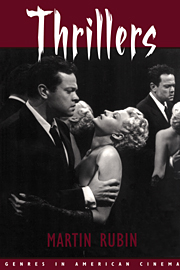Book contents
- Frontmatter
- Contents
- List of Illustrations
- Acknowledgments
- PART I APPROACHES
- PART II HISTORICAL OVERVIEW
- PART III FILM ANALYSES
- 6 The Detective Thriller: The Kennel Murder Case (1933), The Big Sleep (1946)
- 7 The Psychological Crime Thriller: Strangers on a Train (1951)
- 8 The Spy Thriller: Man Hunt (1941)
- 9 The Police Thriller: The French Connection (1971)
- 10 Conclusion
- Notes
- Selected Bibliography
- Filmography/Videography
- Index
7 - The Psychological Crime Thriller: Strangers on a Train (1951)
Published online by Cambridge University Press: 04 December 2009
- Frontmatter
- Contents
- List of Illustrations
- Acknowledgments
- PART I APPROACHES
- PART II HISTORICAL OVERVIEW
- PART III FILM ANALYSES
- 6 The Detective Thriller: The Kennel Murder Case (1933), The Big Sleep (1946)
- 7 The Psychological Crime Thriller: Strangers on a Train (1951)
- 8 The Spy Thriller: Man Hunt (1941)
- 9 The Police Thriller: The French Connection (1971)
- 10 Conclusion
- Notes
- Selected Bibliography
- Filmography/Videography
- Index
Summary
In his history of crime fiction, Bloody Murder (1985), the British novelist and critic Julian Symons draws a fundamental distinction between the “detective story” (by which he means essentially the same thing as the whodunit or classical detective story, discussed in Chapter 6) and the “crime story.” Because the term “crime story” might be misleadingly overgeneralized, the more specific alternative “psychological crime thriller” will be used from this point on.
As the name indicates, a psychological crime thriller is dominated by the psychological motivations and emotional relationships of characters affected by a crime. The question of “whodunit” - central to the classical detective story and less central but still important to the detective thriller - is deemphasized or completely eliminated. There is less concern with concealment and more with characterization.
Raymond Chandler complained that the puzzle-solving aspect of detective stories is inherently obstructive to characterization. In order to conceal the murderer's identity, the writer is obliged to “fake character” - in other words, crucial aspects of the murderer's personality (and also of other prime suspects' personalities) have to be withheld or falsified. In a similar vein, G. K. Chesterton called the detective story “a drama of masks and not of faces” and compared it to a masquerade ball in which no one becomes personally interesting until the clock strikes twelve.
In the psychological crime thriller, the identity of the criminal is usually revealed right away or, at least, very early on.
- Type
- Chapter
- Information
- Thrillers , pp. 203 - 225Publisher: Cambridge University PressPrint publication year: 1999

